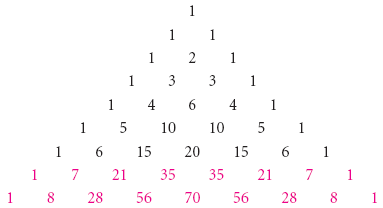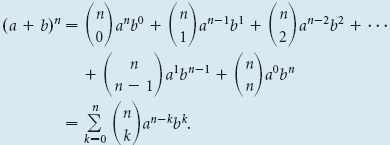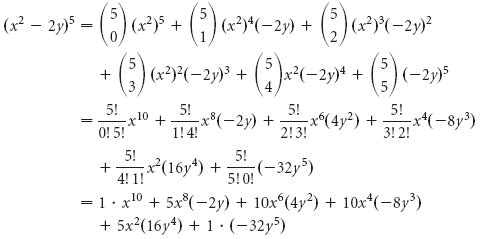The Binomial Theorem
Binomial Expansions Using Pascal’s Triangle
Consider the following expanded powers of (a + b)n, where a + b is any binomial and n is a whole number. Look for patterns.
Each expansion is a polynomial. There are some patterns to be noted.
1. There is one more term than the power of the exponent, n. That is, there are terms in the expansion of (a + b)n.
2. In each term, the sum of the exponents is n, the power to which the binomial is raised.
3. The exponents of a start with n, the power of the binomial, and decrease to 0. The last term has no factor of a. The first term has no factor of b, so powers of b start with 0 and increase to n.
4. The coefficients start at 1 and increase through certain values about "half"-way and then decrease through these same values back to 1.
Let’s explore the coefficients further. Suppose that we want to find an expansion of (a + b)6. The patterns we just noted indicate that there are 7 terms in the expansion:
a6 + c1a5b + c2a4b2 + c3a3b3 + c4a2b4 + c5ab5 + b6.
How can we determine the value of each coefficient, ci? We can do so in two ways. The first method involves writing the coefficients in a triangular array, as follows. This is known as Pascal’s triangle:
There are many patterns in the triangle. Find as many as you can.
Perhaps you discovered a way to write the next row of numbers, given the numbers in the row above it. There are always 1’s on the outside. Each remaining number is the sum of the two numbers above it. Let’s try to find an expansion for (a + b)6 by adding another row using the patterns we have discovered:
We see that in the last row
the 1st and last numbers are 1;
the 2nd number is 1 + 5, or 6;
the 3rd number is 5 + 10, or 15;
the 4th number is 10 + 10, or 20;
the 5th number is 10 + 5, or 15; and
the 6th number is 5 + 1, or 6.
Thus the expansion for (a + b)6 is
(a + b)6 = 1a6 + 6a5b + 15a4b2 + 20a3b3 + 15a2b4 + 6ab5 + 1b6.
To find an expansion for (a + b)8, we complete two more rows of Pascal’s triangle:
Thus the expansion of is
(a + b)8 = a8 + 8a7b + 28a6b2 + 56a5b3 + 70a4b4 + 56a3b5 + 28a2b6 + 8ab7 + b8.
We can generalize our results as follows.
The Binomial Theorem Using Pascal’s Triangle
For any binomial a + b and any natural number n,
(a + b)n = c0anb0 + c1an-1b1 + c2an-2b2 + .... + cn-1a1bn-1 + cna0bn,
where the numbers c0, c1, c2,...., cn-1, cn are from the (n + 1)-st row of Pascal’s triangle.
Example 1 Expand: (u - v)5.
Solution We have (a + b)n, where a = u, b = -v, and n = 5. We use the 6th row of Pascal’s triangle:
1 5 10 10 5 1
Then we have
(u - v)5 = [u + (-v)]5 = 1(u)5 + 5(u)4(-v)1 + 10(u)3(-v)2 + 10(u)2(-v)3 + 5(u)(-v)4 + 1(-v)5 = u5 - 5u4v + 10u3v2 - 10u2v3 + 5uv4 - v5.
Note that the signs of the terms alternate between + and -. When the power of -v is odd, the sign is -.
Example 2 Expand: (2t + 3/t)4.
Solution We have (a + b)n, where a = 2t, b = 3/t, and n = 4. We use the 5th row of Pascal’s triangle:
1 4 6 4 1
Then we have
Binomial Expansion Using Factorial Notation
Suppose that we want to find the expansion of (a + b)11. The disadvantage in using Pascal’s triangle is that we must compute all the preceding rows of the triangle to obtain the row needed for the expansion. The following method avoids this. It also enables us to find a specific term — say, the 8th term — without computing all the other terms of the expansion. This method is useful in such courses as finite mathematics, calculus, and statistics, and it uses the binomial coefficient notation  .
.
We can restate the binomial theorem as follows.
The Binomial Theorem Using Factorial Notation
For any binomial (a + b) and any natural number n, .
.
The binomial theorem can be proved by mathematical induction. (See
Exercise 63.) This form shows why  is called a binomial coefficient.
is called a binomial coefficient.
Example 3 Expand: (x2 - 2y)5.
Solution We have (a + b)n,where a = x2, b = -2y, and n = 5. Then using the binomial theorem, we have
Finally (x2 - 2y)5 = x10 - 10x8y + 40x6y2 - 80x4y3 + 80x2y4 - 32y5.
Example 4 Expand: (2/x + 3√x)4.
Solution We have (a + b)n, where a = 2/x, b = 3√x, and n = 4. Then using the binomial theorem, we have
Finally (2/x + 3√x)4 = 16/x4 + 96/x5/2 + 216/x + 216x1/2 + 81x2.
Finding a Specific Term
Suppose that we want to determine only a particular term of an expansion. The method we have developed will allow us to find such a term without computing all the rows of Pascal’s triangle or all the preceding coefficients.
Note that in the binomial theorem,  gives us the 1st term,
gives us the 1st term,  gives us the 2nd term,
gives us the 2nd term,  gives us the 3rd term, and so on. This can be generalized as follows.
gives us the 3rd term, and so on. This can be generalized as follows.
Finding the (k + 1)-st Term
The (k + 1)-st term of (a + b)n is  .
.
Example 5 Find the 5th term in the expansion of (2x - 5y)6.
Solution First, we note that 5 = 4 + 1. Thus, k = 4, a = 2x, b = -5y, and n = 6. Then the 5th term of the expansion is
Example 6 Find the 8th term in the expansion of (3x - 2)10.
Solution First, we note that 8 = 7 + 1. Thus, k = 7, a = 3x, b = -2, and n = 10. Then the 8th term of the expansion is
Total Number of Subsets
Suppose that a set has n objects. The number of subsets containing k elements  . The total number of subsets of a set is the number of subsets with 0 elements, plus the number of subsets with 1 element, plus the number of subsets with 2 elements, and so on. The total number of subsets of a set with n elements is
. The total number of subsets of a set is the number of subsets with 0 elements, plus the number of subsets with 1 element, plus the number of subsets with 2 elements, and so on. The total number of subsets of a set with n elements is .
.
Now consider the expansion of (1 + 1)n: .
.
Thus the total number of subsets is (1 + 1)n, or 2n. We have proved the following.
Total Number of Subsets
The total number of subsets of a set with n elements is 2n.
Example 7 The set {A, B, C, D, E} has how many subsets?
Solution The set has 5 elements, so the number of subsets is 25, or 32.
Example 8 Wendy’s, a national restaurant chain, offers the following toppings for its hamburgers:
{catsup, mustard, mayonnaise, tomato, lettuce, onions, pickle, relish, cheese}.
How many different kinds of hamburgers can Wendy’s serve, excluding size of hamburger or number of patties?
Solution The toppings on each hamburger are the elements of a subset of the set of all possible toppings, the empty set being a plain hamburger. The total number of possible hamburgers is
Thus Wendy’s serves hamburgers in 512 different ways.

 MENU
MENU